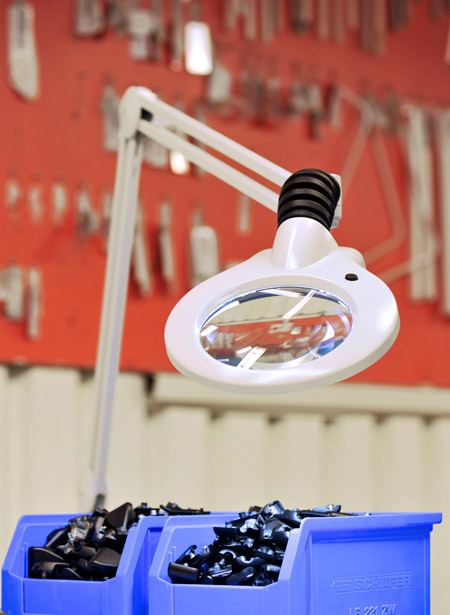General lighting in factory buildings and laboratories is often not enough to determine the quality of goods in production or testing. The lighting therefore needs to be tailored to the products being inspected – their surface structure, colour, reflections, size and the time taken to inspect them.
Diffuse, uniform and shadow-free light is perfect for inspecting matt, shiny or transparent objects, whereas directional light from one or more angles creates modelling shadows and makes it easier to identify scratches or cracks on surface structures. The former can be achieved by using pendant or surface-mounted luminaires at a distance from the work area to secure a high uniformity. The latter can be done with an arm-based task light or luminaires positioned closer to the inspection area. Luminaires with higher colour rendering may be required for colour comparisons.

For the quality control inspection of tiny objects such as circuit board components, magnifying luminaires are the best option. Arm-based magnifiers with square-shaped lenses can switch the light on from both sides of the item being examined and cast modelling light, making the components stand out and errors easier to identify. In the electronics industry, ESD luminaires prevent electrostatic discharges from damaging the goods.
Lighting requirements in EN 12464-1
For chemical industry and textile manufacture and processing
| Type of task / activity area |
Lux-level (Em) |
Glare rating (UGRL) |
Uniformity (U0) |
Colour rendition (Ra) |
Em,z | Em,wall | Em,ceiling | Specific requirements |
|
| required | modified | U0 ≥ 0,10 | |||||||
| Colour inspection | 1 000 | 1500 | 19 | 0,70 | 90 | 150 | 150 | 100 | 4000 K ≤ CCT ≤ 6500 K |
| Cutting, finishing, inspection | 750 | 1000 | 19 | 0,70 | 80 | 150 | 150 | 100 | |
For food industry
| Type of task / activity area |
Lux-level (Em) |
Glare rating (UGRL) |
Uniformity (U0) |
Colour rendition (Ra) |
Em,z | Em,wall | Em,ceiling | Specific requirements |
|
| required | modified | U0 ≥ 0,10 | |||||||
| Laboratories | 500 | 750 | 19 | 0,60 | 80 | 150 | 150 | 100 | |
For electrical and electronics industry
| Type of task / activity area |
Lux-level (Em) |
Glare rating (UGRL) |
Uniformity (U0) |
Colour rendition (Ra) |
Em,z | Em,wall | Em,ceiling | Specific requirements |
|
| required | modified | U0 ≥ 0,10 | |||||||
| Electronic workshops, testing, adjusting | 1 500 | 2000 | 16 | 0,70 | 80 | 150 | 150 | 100 | |
For metal working and processing
| Type of task / activity area |
Lux-level (Em) |
Glare rating (UGRL) |
Uniformity (U0) |
Colour rendition (Ra) |
Em,z | Em,wall | Em,ceiling | Specific requirements |
|
| required | modified | U0 ≥ 0,10 | |||||||
| Scribing: inspection | 750 | 1000 | 19 | 0,70 | 80 | 150 | 150 | 100 | |
For wood working and processing
| Type of task / activity area |
Lux-level (Em) |
Glare rating (UGRL) |
Uniformity (U0) |
Colour rendition (Ra) |
Em,z | Em,wall | Em,ceiling | Specific requirements |
|
| required | modified | U0 ≥ 0,10 | |||||||
| Quality control, inspection | 1 000 | 1500 | 19 | 0,70 | 90 | 150 | 150 | 100 | 4000 K ≤ CCT ≤ 6500 K |
For vehicle construction and repair
| Type of task / activity area |
Lux-level (Em) |
Glare rating (UGRL) |
Uniformity (U0) |
Colour rendition (Ra) |
Em,z | Em,wall | Em,ceiling | Specific requirements |
|
| required | modified | U0 ≥ 0,10 | |||||||
| Final inspection | 1 000 | 1500 | 19 | 0,70 | 90 | 150 | 150 | 30 | |
For rolling mills, iron and steel works
| Type of task / activity area |
Lux-level (Em) |
Glare rating (UGRL) |
Uniformity (U0) |
Colour rendition (Ra) |
Em,z | Em,wall | Em,ceiling | Specific requirements |
|
| required | modified | U0 ≥ 0,10 | |||||||
| Test, measurement and inspection | 500 | 750 | 22 | 0,60 | 80 | 150 | 150 | 100 | |
